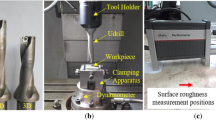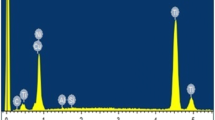Abstract
Laser-based surface texturing provides highly controlled interference fit between two parts. In this work, artificial intelligence-based models were used to predict the surface properties of laser processed stainless steel 316 samples. Artificial neural network (ANN) and adaptive neuro-fuzzy inference system (ANFIS) were used to predict the characteristics of laser surface texturing. The models based on feedforward neural network (FFNN) were developed to examine the effect of the laser process parameters for surface texturing on 316L cylindrical pins. The accuracy of the models was measured by calculating the root mean square error and mean absolute error. The reliability of the ANFIS and FFNN models for the output prediction of the laser surface texturing (LST) system were investigated by using the data measured from experiments based on a 3^3 factorial design, with main processing parameters set as laser power, pulse repetition frequency, and percentage of laser spot overlap. The relative assessment of the models was performed by comparing percentage error prediction. Finally, the impact of input data was examined using predicted response surface plots. Results showed that ANFIS prediction was 48% more accurate compared with that provided by the FFNN model.









Similar content being viewed by others
References
Murcinkova Z, Baron P, Pollak M (2018) Study of the press fit bearing-shaft joint dimensional parameters by analytical and numerical approach. Adv Mater Sci Eng
Obeidi M, McCarthy E, Kailas L, Brabazon D (2018) Laser surface texturing of stainless steel 316L cylindrical pins for interference fit applications. J Mater Process Technol 252:58–68
Hüyük H, Music O, Koç A, Kardogan C, Bayram C (2014) Analysis of elastic-plastic interference-fit joints. Procedia Engineering 81:2030–2035
H. Sohrabpoor, A. Issa, A. Hamaoy, I. Ahad, E. Chikarakara, K. Bagga, D. Brabazon, Development of laser processing technologies via experimental design, Chapter 24, pp. 707–730, 2nd edn, 2017
Aminian M, Teimouri R (2015) Application of soft computing techniques for modeling and analysis of MRR and taper in laser machining process as well as weld strength and weld width in laser welding process. Soft Comput 19:793–810
Biswas A, Rajat S, Gupta R (2018) Application of artificial neural network for performance evaluation of vertical axis wind turbine rotor. Int J Ambient Energy 37(2):1–10
sohrabpoor H (2016) Analysis of laser powder deposition parameters: ANFIS modeling and ICA optimization. Optik 127(8):4031–4038
Sohrabpoor H, Negi S, Shaiesteh H, Ahad IU, Brabazon D (2018) Optimizing selective laser sintering process by grey relational analysis and soft computing techniques. Optik 174:185–194
Umrao R, Sharma L, Singh R, Singh T (2018) Determination of strength and modulus of elasticity of heterogenous sedimentary rocks: An ANFIS predictive technique. Measurement 126:194–201
Teimouri R, Shrabpoor H (2013) Application of adaptive neuro-fuzzy inference system and cuckoo optimization algorithm for analyzing electro chemical machining process. Front Mech Eng 8(4):429–442
Gholami A, Bonakdari H, Ebtehaj I, Mohammadi M, Gharabaghi B, Khodashenase S (2018) Uncertainty analysis of intelligent model of hybrid genetic algorithm and particle swarm optimization with ANFIS to predict threshold bank profile shape based on digital laser approach sensing. Measurement 121:294–303
Fister I, Perc M, Kamal S, Fister I (2015) A review of chaos-based firefly algorithms: Perspectives and research challenges. Appl Math Comput 252(1):155–165
Pandremenos J, Chryssolouris G (2011) A neural network approach for the development of modular product architectures. Int J Comput Integr Manuf 24(10):879–887
Karagiannis S, Stavropoulos P, Ziogas C, Kechagias J (2013) Prediction of surface roughness magnitude in computer numerical controlled end milling processes using neural networks, by considering a set of influence parameters: an aluminium alloy 5083 case study. Proc Inst Mech Eng B J Eng Manuf 228(2):233–244
Ojha V, Abraham A, Snášel V (2017) Metaheuristic design of feedforward neural networks: a review of two decades of research. Eng Appl Artif Intell 60:97–116
Baseri H, Damirchi H (2011) Rediction of the ferrite-Core probe performance using a neural network approach. Mater Manuf Process
Shamsipour M, Pahlevani Z, Ostad M, Mazahery S (2016) Optimization of the EMS process parameters in compocasting of high-wear-resistant Al-nano-TiC composites. Appl Phys A 122
Acı M (2016) Artificial neural network approach for atomic coordinate prediction of carbon nanotubes. Appl Phys A 122
Obeidi MA, McCarthy E, Brabazon D (2016) Methodology of laser processing for precise control of surface micro-topology. Surf Coat Technol 307(Part A)
Tsamardinos I, Greasidou E, Borboudakis G (2018) Bootstrapping the out-of-sample predictions for efficient and accurate cross-validation. Mach Learn 107(12):1895–1922
Yurdakul M, Tansel İÇ Y (2009) Application of correlation test to criteria selection for multi criteria decision making (MCDM) models. Int J Adv Manuf Technol 40:403–412
Funding
This research is supported by a research grant from the Science Foundation Ireland (SFI) under Grant Number 16/RC/3872 and is co-funded under the European Regional Development Fund and by I-Form industry partners. This work is also supported by Irish Research Council Government of Ireland Scholarship.
Author information
Authors and Affiliations
Corresponding author
Additional information
Publisher’s note
Springer Nature remains neutral with regard to jurisdictional claims in published maps and institutional affiliations.
Rights and permissions
About this article
Cite this article
Sohrabpoor, H., Mousavian, R.T., Obeidi, M. et al. Improving precision in the prediction of laser texturing and surface interference of 316L assessed by neural network and adaptive neuro-fuzzy inference models. Int J Adv Manuf Technol 104, 4571–4580 (2019). https://doi.org/10.1007/s00170-019-04291-z
Received:
Accepted:
Published:
Issue Date:
DOI: https://doi.org/10.1007/s00170-019-04291-z




